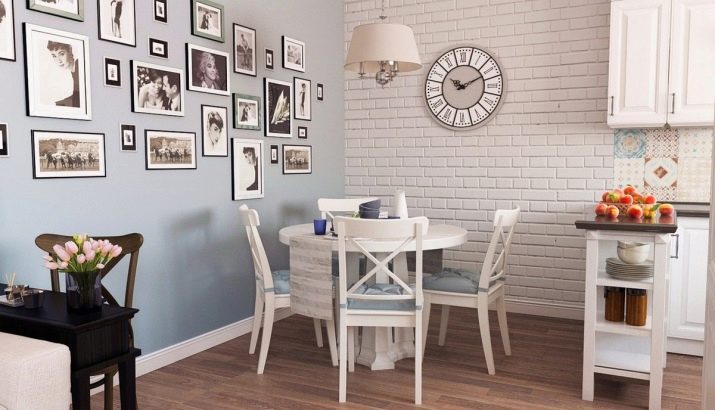Kitchen wall design
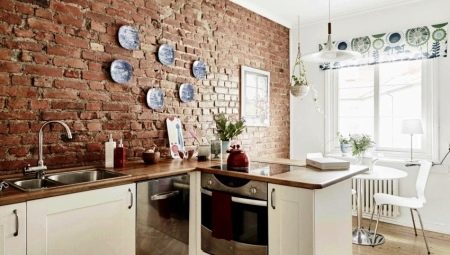
Wall decoration plays an important role in the design of a room. With the help of the subtleties of decoration, you can make the kitchen stylish and cozy, zone the space, emphasize the advantages of the layout and hide the flaws. The article will tell you about the options for wall decoration, the choice of material and colors.
Varieties of finishes
Various materials can be used to decorate the walls of a kitchen room in an apartment or a country house. Which one is better is difficult to answer unequivocally. Each has its own merits and demerits. The choice is made based on the style of the premises, financial capabilities and personal preferences of the owners.
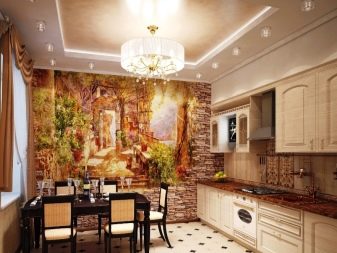
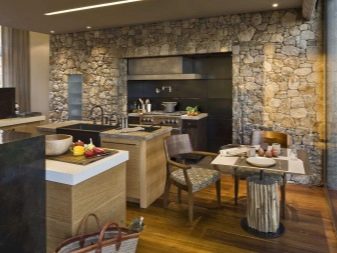
Wallpaper
It is not worth wallpapering the work area (next to the stove, sink). But for other walls, this material is quite suitable. The main thing is to choose moisture resistant options.
- Paper products with water-repellent impregnation are the cheapest. However, they fade, absorb odors and can quickly lose their appearance due to the humid microclimate of the kitchen.
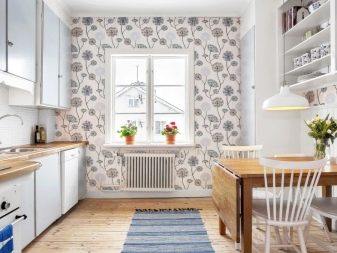

- Vinyl canvases more durable, have a synthetic upper layer. They do not fade and can be wet cleaned. However, they do not allow air to pass through at all, which can contribute to the appearance of fungus. To avoid this, you need to ventilate the room daily, especially if the temperature and humidity are high.

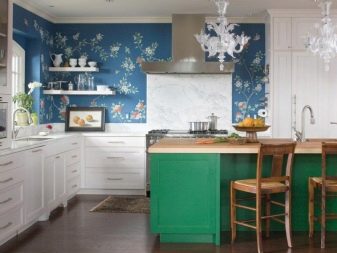
- Silkscreen wallpaper - a kind of vinyl. They are distinguished by the presence of silk threads in the composition, which gives an imitation of luxurious fabric. Such products require a perfectly flat surface for gluing.
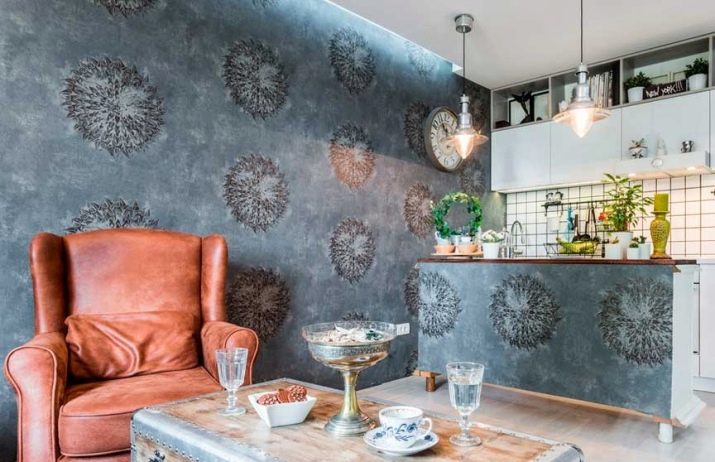
- Non-woven products strong, durable, resistant to high temperatures and humidity, have an interesting texture, allow the walls to "breathe". However, they are more expensive than other models.
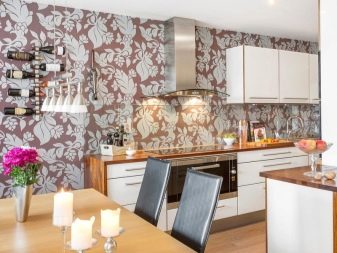

The colors and prints should be chosen based on the style of the interior and the decor of the room. For example, calm, noble tones are suitable for classics. Subtle patterns (floral ornaments, medallions) are acceptable. Minimalism and hi-tech imply monochromatic coatings. If you have chosen Provence for your kitchen design, you can decorate it with striped wallpaper or canvases in a small flower. Modern gives room for imagination, but you should not buy too colorful wallpaper if your furniture is not uniform. Otherwise, you will quickly get bored with a riot of colors and prints.
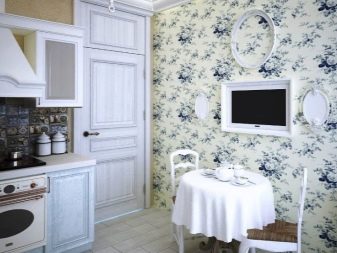
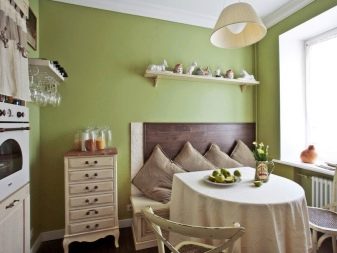
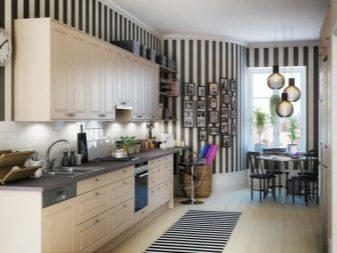
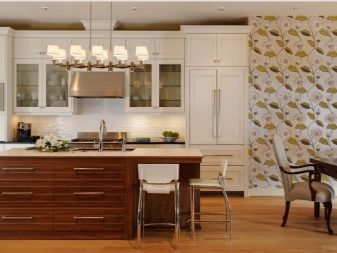
An interesting idea is to use photo wallpaper to highlight an accent wall or create a visual effect of increasing the area of a room. A tricky move - using wallpaper that imitates the texture of some other materials (for example, brick or stone).
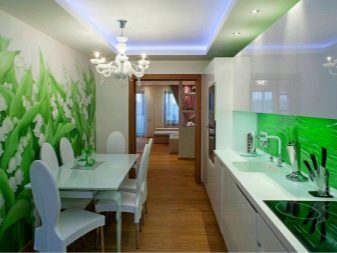
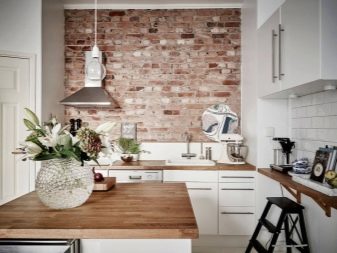
Plastic
Plastic panels are another relatively budget type of decorative trim. The material is reliable, durable, looks good, easy to clean. Often, plastic is used to decorate a kitchen backsplash, but if desired, it can be used to decorate other walls.
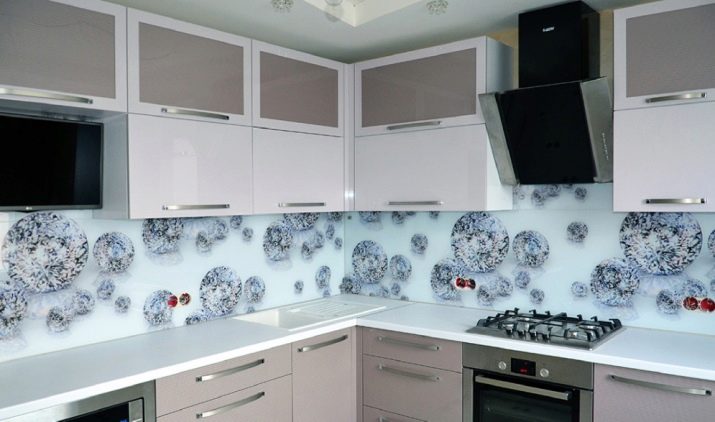
Of course, such a finish will not work for an elegant classic. But in modern styles, it can look pretty good. One has only to take into account the low resistance of the material to mechanical stress (a crack can form from impact), the ability to lose light under prolonged exposure to ultraviolet radiation. And, of course, do not forget that when decorating walls with panels, as much as 4 centimeters are lost, which is undesirable for small rooms.
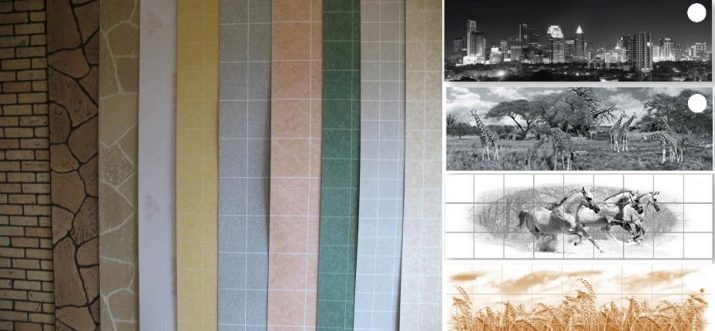
Tile
Wall decoration with ceramic tiles is a reliable option. The material is durable, moisture resistant, easy to clean, and fireproof. This finish will serve the owners of the house for many years. However, only the backsplash is usually tiled. It is not recommended to use it to decorate the entire kitchen, although in some cases it may look quite good (for example, if the tile imitates brick).
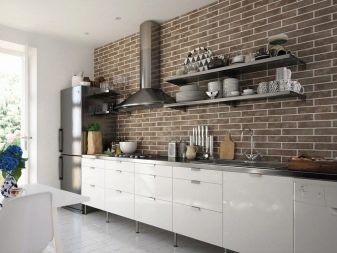
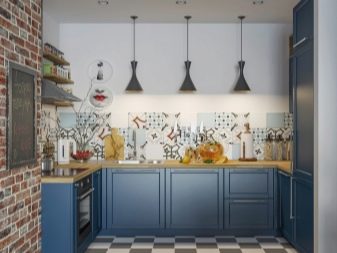
Tiled covering of a large wall area can be entered into loft, country, Scandinavian styles. The ceramic apron looks good in any interior. The main thing is to choose the appropriate shape, color and pattern. For example, the Provence style can be emphasized with square patchwork tiles, and for a neoclassical interior, you can choose a snow-white "hog" or a mosaic.
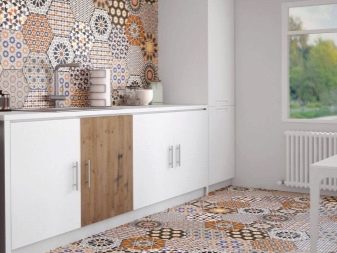
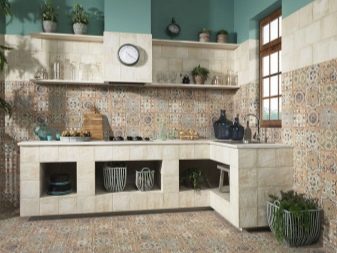
Stone
Decorative stone looks solid, noble and expensive. It looks especially good in vintage interior styles, although it can also fit into modern. The material is durable, withstands high temperatures, does not absorb dirt and grease, it is not afraid of biological threats (fungus, mold).
However, such a finish is quite expensive. In addition, the material is of considerable weight. Decorating walls with it requires special skills. Therefore, it is better to make sure that the wall can withstand such a weight, find the thinnest tiles and seek the help of professional craftsmen, without trying to finish it yourself.
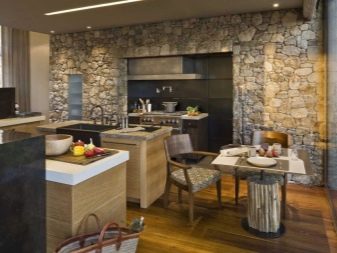
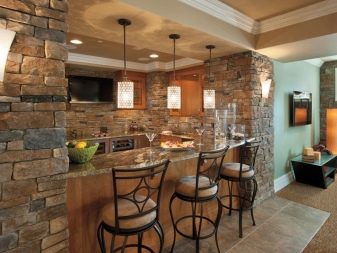
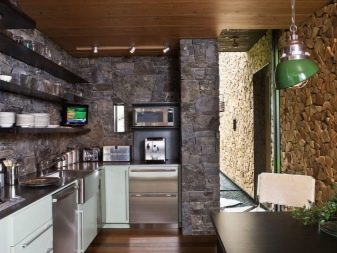
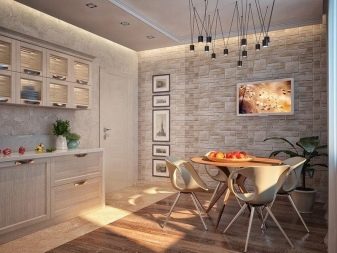
Often the stone is combined with painting or plaster. Such an interior looks lighter and more interesting.
Decorative plaster
This material is capable of creating a unique design. When decorating, a special type of material is used, applied to the main layer. Different patterns can be obtained depending on the tools used and the method of application of the composition.
The material does not require preliminary leveling of the wall, masks small defects. The coating is durable, resistant to moisture and mechanical stress. It does not absorb odors and dirt, it looks presentable. The only drawback of this finish is its high cost.


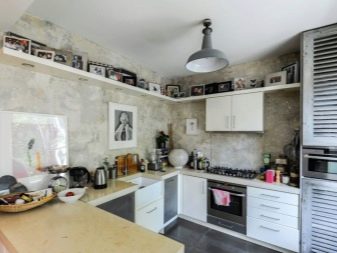
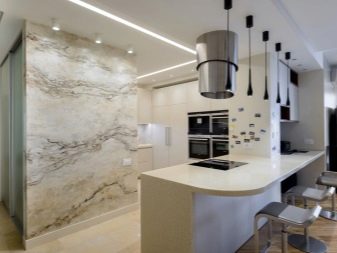
There are several types of decorative plaster.
- Roller. Creates a three-dimensional pattern, can be painted after application.

- Latex. Able to imitate natural stone. The shading takes place during the mixing process.
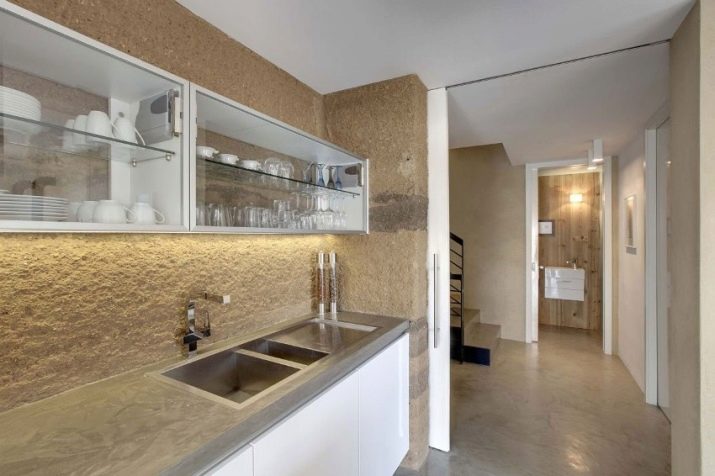
- "Wet Silk". Forms a coating with the effect of a delicate satin fabric.
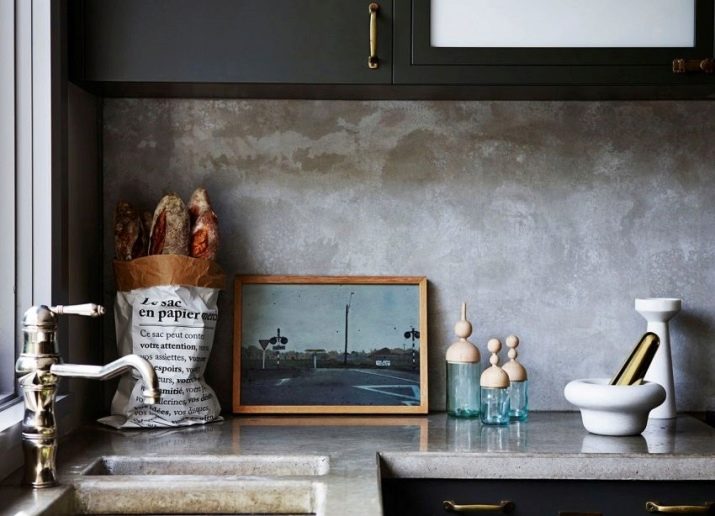
- "Sea breeze". This species casts beautifully with mother-of-pearl.
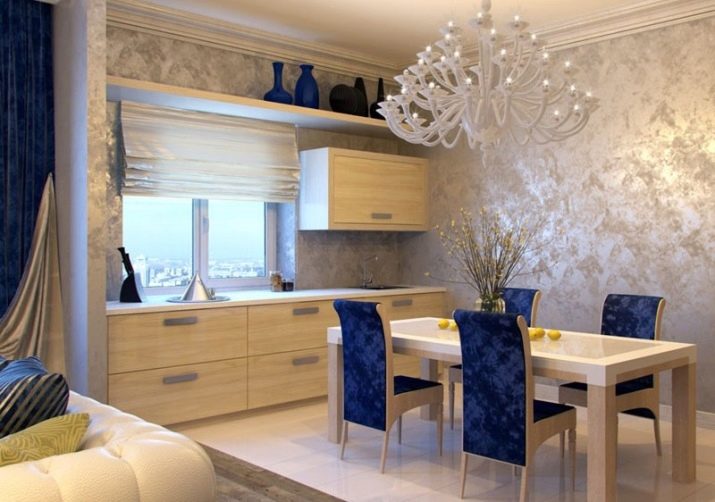
Decorating walls with plaster requires great care. To enhance the protection of the coating, it can be fixed with a special wax.
Brick
The use of bricks for interior decoration is an interesting solution. This method of decoration can favorably emphasize the originality of country and Provence, give more brutality to a loft-style kitchen. The material can have a reddish-brown or grayish natural hue or be painted white. Snow-white brickwork looks more sophisticated, so it can fit into both classic interiors and modern rooms.
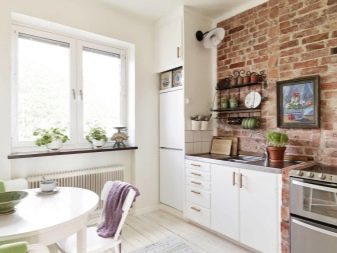
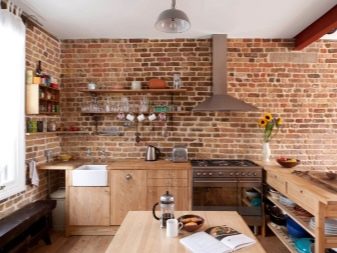
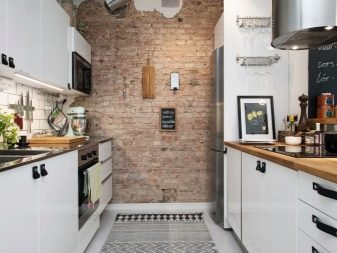
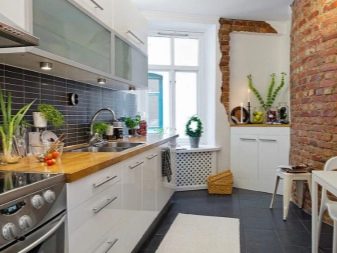
The advantages of the material are known to everyone. It is strong, durable, reliable, resistant to any impact. Subsequently, if you wish, you can easily change the design by applying plaster to the brick. The resulting surface can be painted or pasted over with wallpaper.
Cork
This natural material is rarely used in interior design. It fits perfectly into eco-style, but in other cases it is not very effective. At the same time, the cork can create good sound and heat insulation. It does not accumulate dust, is resistant to moisture, and is not prone to mold formation. The only negative is that the coating fades in the sun. In addition, it is advisable to maintain a stable humidity in such a room, otherwise the boards may dry out slightly.
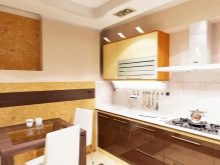
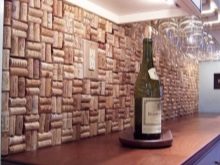
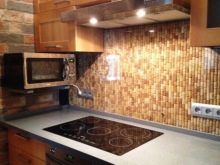
Wooden lining
MDF slats look great in the country, as well as when creating a rustic or Scandinavian style in an apartment. In the latter case, the wood is painted white. In the style of Provence, a light gray or blue tone of the walls will be relevant. Country assumes natural shades of wood. The lining must be protected from the negative effects of moisture and heat with a special coating.
With this design, open wooden shelves, wall clocks, small pictures in frames look great. You can combine the lining with wallpaper or painted surfaces. In this case, the tree is located at the bottom of the wall.
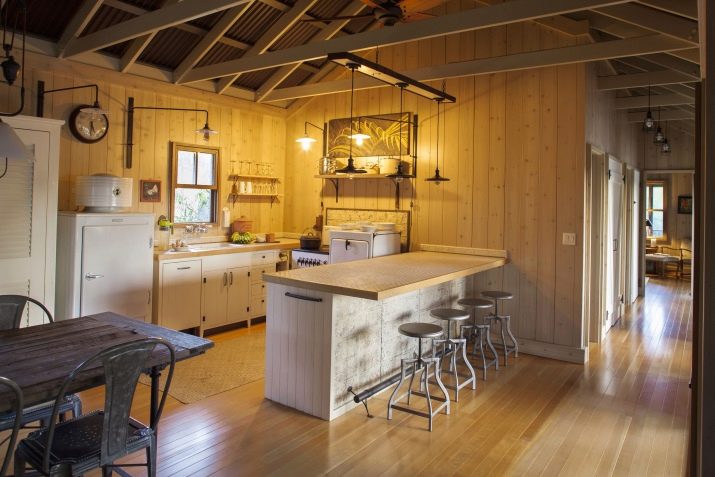
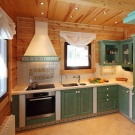
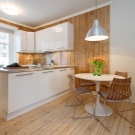


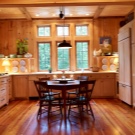
Dye
Painting is the simplest and most versatile method of wall decoration, appropriate for any style. Water-based paint is suitable for the kitchen. It is hypoallergenic, odorless and dries quickly, and the result is pleasing to the eye. The painted glossy surface can be washed. If the walls are not perfect, you can use matte paint. It will visually hide defects.
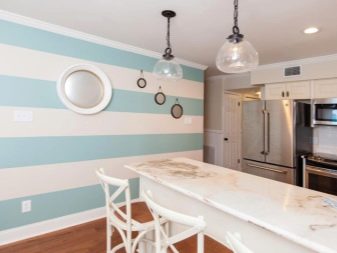
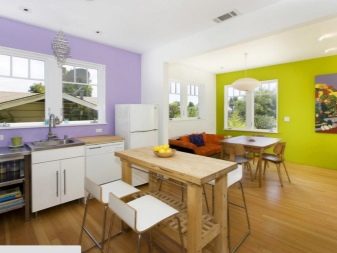
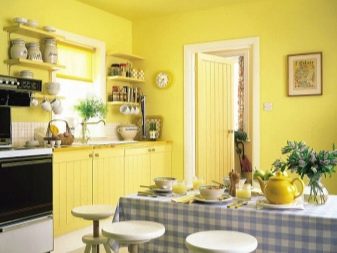
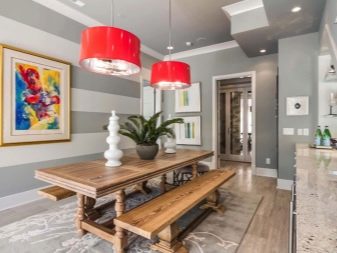
Flock coating
This is a very unusual decorative coating that includes many small flake-like particles. The work is carried out in 3 stages. First, a special acrylic adhesive is applied. The flakes are then sprayed from a gun or compressor. After 12 hours, all this beauty is fixed with two layers of finishing varnish.
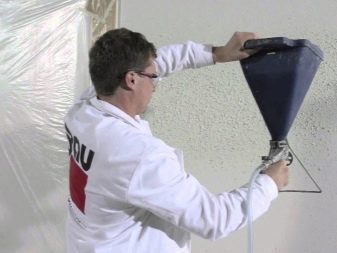
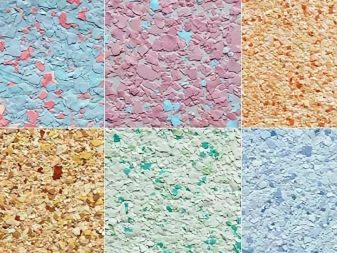
The flakes can be of different shapes and colors. The coating can be either monochromatic or variegated, have a metallized or pearlescent sheen. The material is durable, easy to clean (the wall can be wiped with a damp cloth). The coating is environmentally friendly, does not fade in the sun and looks luxurious. The disadvantages include the high price and complexity of installation.
How to choose a color?
For small rooms, light colors are more suitable, visually expanding the space (white, beige, pastel shades). In a spacious kitchen, darker, more saturated colors are acceptable. Warm tones make the room cozier, while cold tones create a feeling of freshness even on a hot day. In addition to the size of the room and personal preferences, the style of the interior should also be taken into account when choosing the color of the walls.
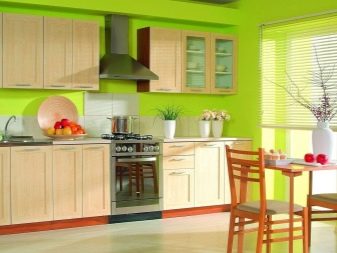
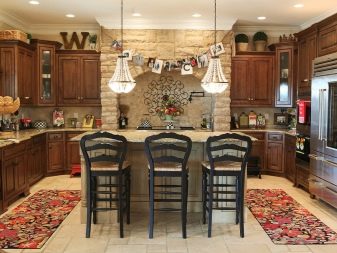
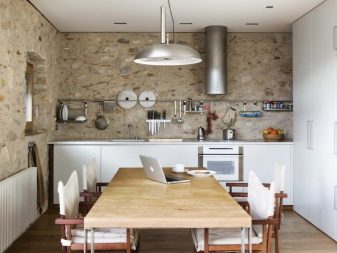
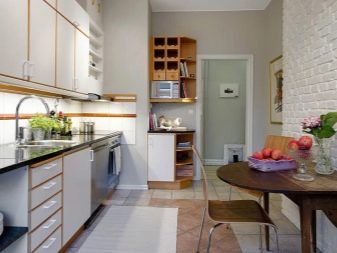
We take into account the style
Each style has its own materials and shades. Classic vintage styles call for soft, muted tones. Bright colors are acceptable in a modern setting. White is a universal color, it is always appropriate.
The choice of prints is also specific. Stripes and small flowers are appropriate in Provence, monograms - in the classics. Modern rooms are often decorated with photo wallpaper or other decor, preferring monochromatic coatings. Sometimes they choose wallpaper with geometric patterns and plant themes.
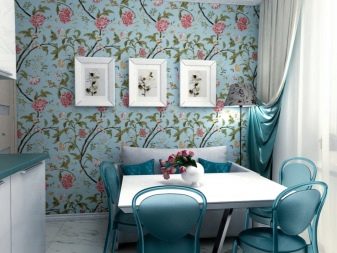
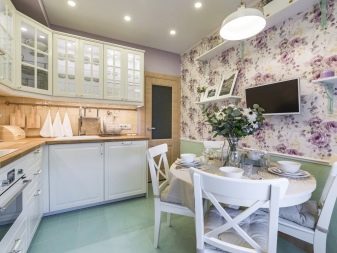
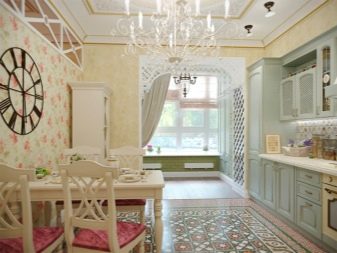
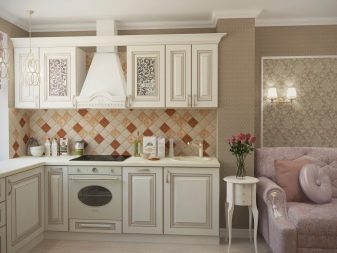
As for materials, the classics allow painting, finishing with stone or decorative plaster, wallpaper. Wallpaper, clapboard and brick fit into rustic styles. The rough style of a loft is usually emphasized by brick or paint. The cork is ideal for eco-interiors. Minimalism and high-tech styles are characterized by plastic finishing, painting, ceramic tiles.
Interesting ideas for decorating walls in the kitchen
Every kitchen always has at least two areas: a dining area and a cooking area. Let's consider how you can choose the design of the walls in each of them.
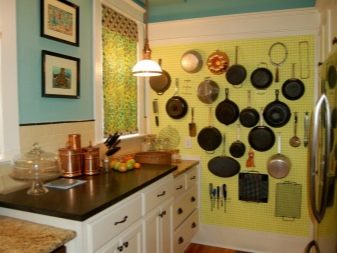
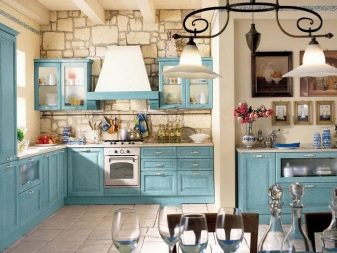
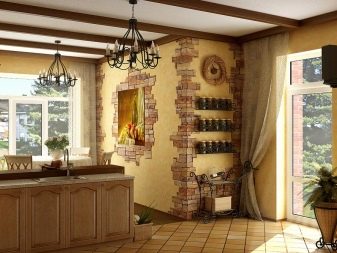
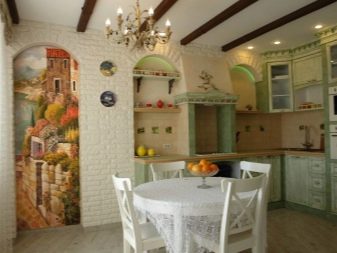
Near the dining table
If the wall next to the table is free, you can decorate it with photo wallpaper. The theme is selected based on the style and colors of the furnishings. Panoramic images are recommended for small kitchens. A sandy beach, a terrace with a picturesque view or a street with flowering trees stretching into the distance - there are many options. This technique imitates the continuation of the room, visually expanding it.
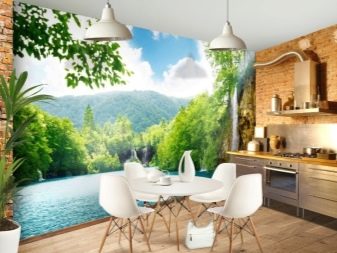
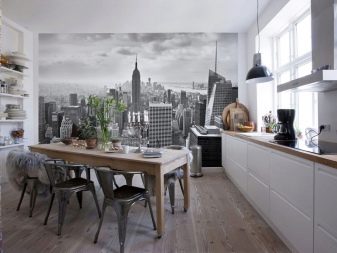
Another option for visual correction of space is a mirror. The entire wall or part of it can be mirrored. This technique is used especially often in neoclassicism.

In the working area
An apron can be an interesting accent or a modest and neutral one. In the second case, it is a plain tile or plastic. To highlight this area, you can use a ceramic panel, mosaic or glass apron with photo printing.


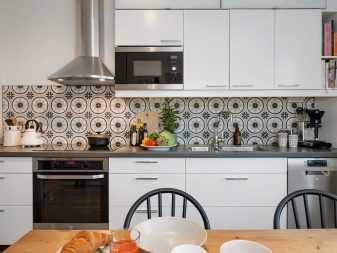
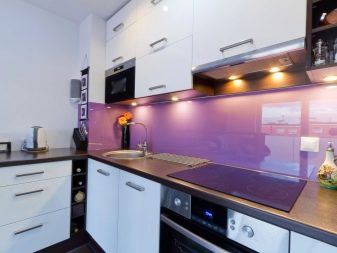
Accent wall options
In addition to photo wallpaper, there are other ways to effectively design an accent wall. For example, it can be a finish from a different material, ordinary wallpaper with a catchy print, or art painting. A modern and unusual option is a painted slate board or chalk wallpaper. You can also paint the entire wall or part of it with graphite paint. On such a surface, household members can write their plans for the day or wishes for each other, leave funny drawings and notes.
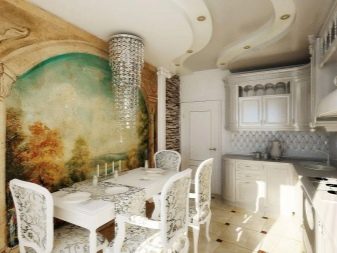
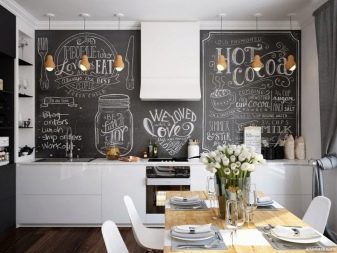
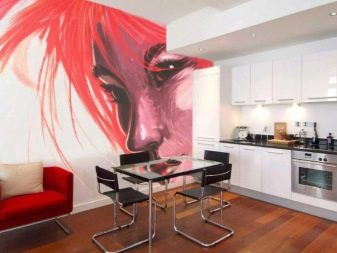
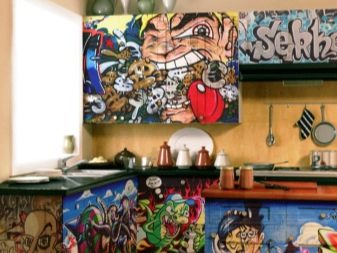
Use of decor elements
Additionally, the walls can be decorated with different decor. There are many options: modular and conventional paintings, posters, framed photographs under glass, wall clocks. Elegant sconces are appropriate in classic interiors. Rustic style can be emphasized by shelves with beautiful dishes and souvenirs, cutting boards, decorative plates. Interior letters look interesting with or without illumination. Solid walls in a modern kitchen can be complemented with vinyl decals.
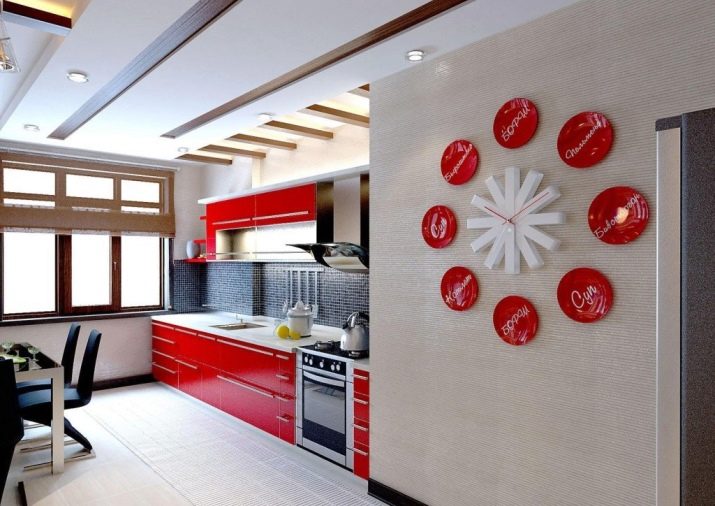
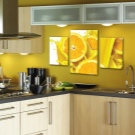
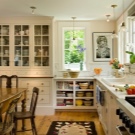
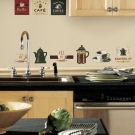
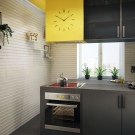

Tips for combining different materials
If the kitchen is very small, you can use one material to decorate the walls, for example, painting or finishing with ceramic tiles.
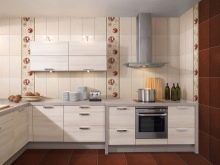
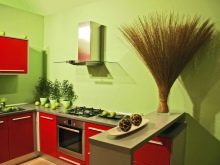

If the room is more spacious, it makes sense to make zoning. The finishing of the working area should be as resistant to dirt, steam, and water as possible. The wall décor in the dining area can be more sophisticated. For example, you can combine a beautiful printed glass or ceramic backsplash with plain walls. Plaster, flock, wallpaper can be used here. If you plan to highlight an accent wall, it is better to make the apron neutral so as not to overload the interior.
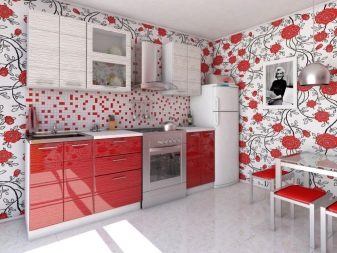
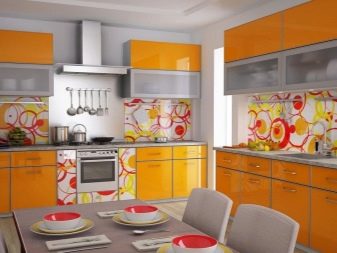
Most difficult finishes where three materials are combined (no longer recommended). It is better to involve experienced designers for such experiments. For example, it could be a combination of plaster, stone and tiles for a classic kitchen work area.Another example is paint, glossy plastic and high-tech apron glass.
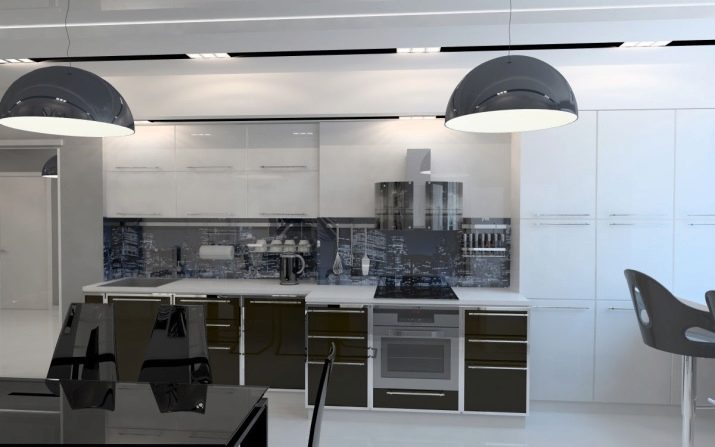
Beautiful examples in the interior
Consider interesting options for wall decoration in the kitchen.
- White wallpaper with blue flowers fits perfectly into the aesthetics of the shabby chic style.
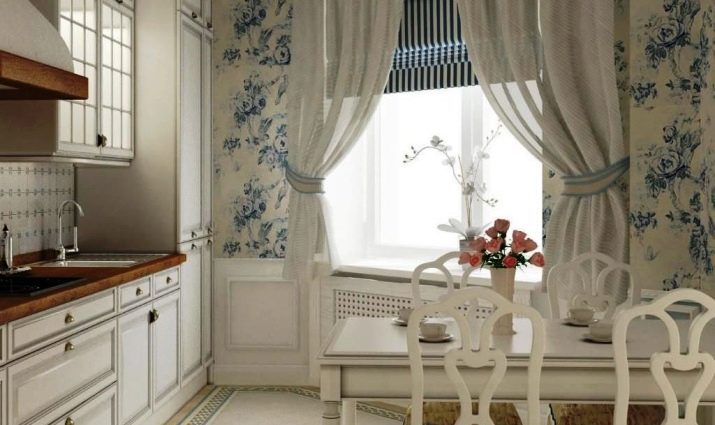
- Black, white and gray are the typical colors of minimalism. Imitation of brickwork goes well with plain surfaces.
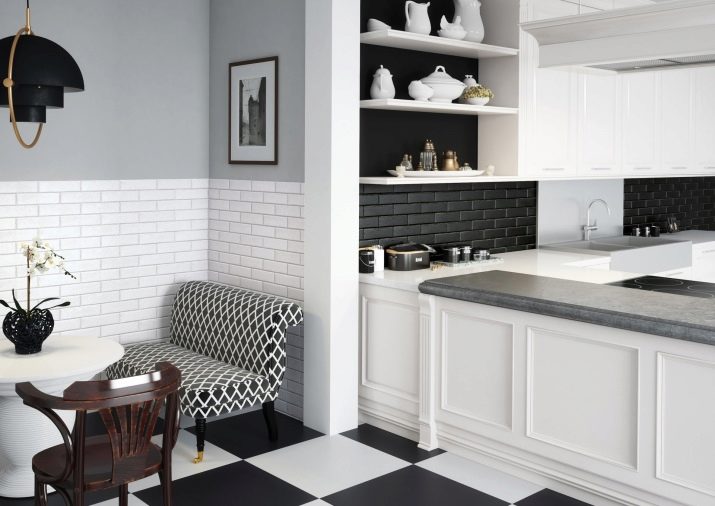
- Monochrome bright color can be diluted with delicate photo wallpaper.

- The classic elegance of the setting and the illusion of a luxurious sea view create a romantic mood.

- Black and white photos and wall clocks are great decor for retro style. Patchwork tiles in light colors gently highlight the work area.
